ISSN ONLINE(2278-8875) PRINT (2320-3765)
ISSN ONLINE(2278-8875) PRINT (2320-3765)
| R. Santhos kumar1 and M.Murugesan2 |
| Related article at Pubmed, Scholar Google |
Visit for more related articles at International Journal of Advanced Research in Electrical, Electronics and Instrumentation Engineering
In this paper, two DC-DC converters are designed for Hybrid Electric Vehicle System (HEVS) in order to improve overall performance of Electric motor’s running condition and charging controller for Storage elements (Battery).These two converters are termed as Front End Converter (FEC) and Rear End Converter (REC). First one act as a charging controller for Battery, later one works in order to improve running condition of a electric vehicle. A Zero Voltage Switching (ZVS) is implemented in front end converter to reduce the switching losses of switching devices. In addition to this, Front End Converter achieves near unity power factor by having additional auxiliary circuit in it. On the other hand, Rear End Converter works in such a way that it connects hybrid Energy Storage elements to motor unit depending on it’s running performance. Simply to say, Rear end converter connects a Battery to motor when power density requirement is lees, But it connects Ultra Capacitor during higher power density requirement. This paper is simulated in user friendly tool of MATLAB/Simulink 2010.
KEYWORDS |
| Hybrid Electric Vehicles, Battery, Ultra Capacitor Front End Converter, Rear End converter, ZVS, Power factor, MATLAB/Simulink. |
INTRODUCTION |
| Electric vehicles are becoming increasingly important as not only do they reduce noise and pollution, but also they can be used to reduce the dependence of transport on oil – providing that the power is generated from fuels other than oil. The basic idea of a HESS is to combine either ultra-capacitors (UC) or Fuel Cell (FC) or batteries to achieve a better overall performance. This is because, compared to batteries, ultra-capacitors have a high power density, but a lower energy density. Similarly Fuel cell has a controllable output power while battery does have fixed fuel material. This combination inherently offers better performance in comparison to the use of either of them alone. Several configurations for HESS designs have been proposed, which range from simple to complex circuits.. Conventional active methods use one or multiple full size DC/DC converters to interface the energy storage device to the DC-link. In this case, full size refers to the fact that the DC/DC converter forms the sole path for the flow of energy in the device. |
| LITEARTURE SURVEY: Electric vehicles can also be used to reduce carbon emissions. Production of zero release of carbon dioxide requires that the energy for electric vehicles is produced from non-fossil-fuel sources such as nuclear, fuel, chemical energy (Battery) and renewable energy sources [1],[2]. Generally Electric vehicles are depends on only one primary source (Battery).Such, a battery based ESS has several challenges providing the impetus to look for additional solutions. In battery-based energy storage systems, power density of the battery needs to be high enough to meet the peak power demand. Although batteries with higher power densities are available, they are typically priced much higher than their lower power density counterparts [3]. A typical solution to this problem is to increase the size of the battery. However, this also causes an increase in cost. Further it require instantaneous power input and output typically Find batteries suffering from frequent charge and discharge operations, which have an adverse effect on battery life [6], [7]. For such systems, it is difficult to have an additional energy storage system or a buffer which is much more robust in handling surge current. Hybrid electric vehicles have had major focus in recent years and they have made leaps and bounds in development [5]. |
| Through this paper, a new DC-DC converter is proposed for Hybrid Electric Vehicle System (HEVS) in order to improve overall performance of Energy storage elements such as Battery and Ultra Capacitor (UC). Compared with conventional DC-DC converter, proposed one is much smaller which working as a controlled circuit to select which Energy storage element should deliver power to electric motor in HEVS. Proposed DC-DC converter works in such a way that it connects battery directly with Electric motor during less power demand condition while it connects UC with Electric motor during peak power demand operating condition (Because of UC has higher power density than Battery). In addition to this, proposed DC-DC converter acts as a Buffer circuit which effectively prevents battery from frequent charges from regenerative modes of operation of HEVS. This feature ensures increase in life span of Battery. |
| The proposed system will be presented and verified in detail in this paper. The paper is presented as follows. Section II presents general introduction to Hybrid Electric vehicle Systems and details on Front End Converter, Rear End converter topology. Section III discusses the controlling technique and operating modes of the proposed converters. Section IV focuses on MATLAB simulation results followed by the conclusion, which is in Section V. |
II.OVERVIEW OF HYBRID ELECTRIC VEHICLE SYSTEMS |
| An all-electric vehicle is powered by electricity with a large, rechargeable battery, an electric motor, a controller that sends electricity to the motor from the driver’s accelerator pedal, and a charging system. These parts of an electric vehicle replace the IC engine, fuel tank, fuel line, and exhaust system in a traditional car, while the IC engine is central to the operation of a traditional vehicle; it is the rechargeable battery that is central to the operation of an electric vehicle. |
| Table 1 compares different combination of Hybrid Electric Vehicle Systems lists and its application. There are still so many techniques are rising world wide to remove drawbacks in storage systems in Hybrid electric vehicle. |
| A. Front End Converter topology |
| In this paper, a novel interleaved boost PFC converter is proposed to achieve soft switching in the main switches of the converter. This charging controller consisted by interleaved boost converter and its auxiliary converter. Interleaved boost converter having two boost stages which works 180 degree out of phase. The proposed converter implements soft switching through a simple passive auxiliary circuit placed in between the two phases of the interleaved boost converter. This auxiliary circuit is able to provide reactive current to charge and discharge the output capacitors of the boost MOSFETs and guarantee ZVS. Since there are no extra semi conduct ors used in the auxiliary circuit, high efficiency and reliability are the main advantages of the proposed system. In addition, the proposed converter is able to optimize the amount of reactive current required to implement soft switching based on the load condition and the input voltage. Thus, the conduction losses caused by the auxiliary circuit are minimized based on the operating condition. |
| The main sources of switching losses in boost PFC converters are hard turn-ON of the MOSFET and the reverse recovery of the boost diode during its turn-OFF which is normally occurred in existing methods of active clamp converter technique. In order to eliminate the switching losses in a MOSFET-based boost PFC converter, different auxiliary circuits have been proposed. |
 |
| Figure 1 shows a block diagram of hybrid electric vehicle systems. Hybrid Electric Vehicles uses two or more different kind of Energy storage elements like Battery, Ultra Capacitors, Fuel cell and PV cell. Each element has their own merits and demerits |
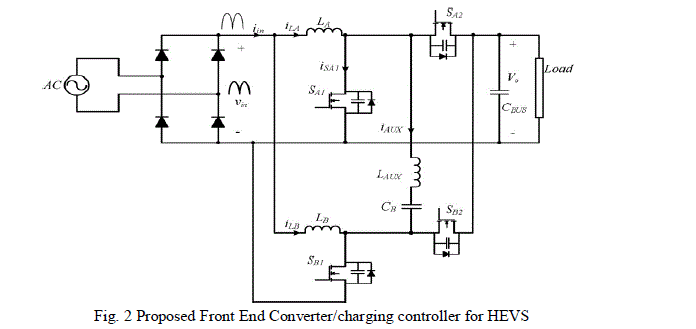 |
| Figure 2 shows Front End converter circuit diagram. This converter has totally 4 MOSFETS two are work as as Boost converter, remaining are auxiliary switch to improve power factor |
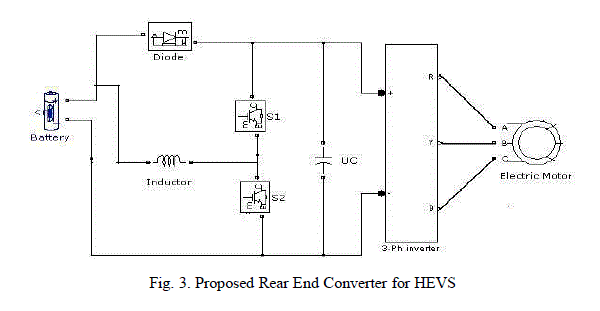 |
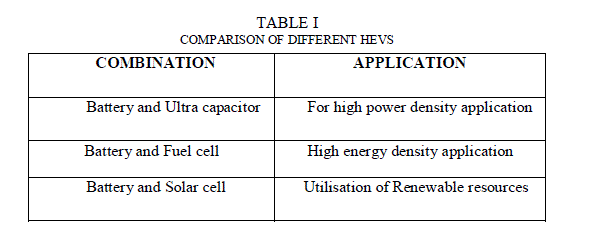 |
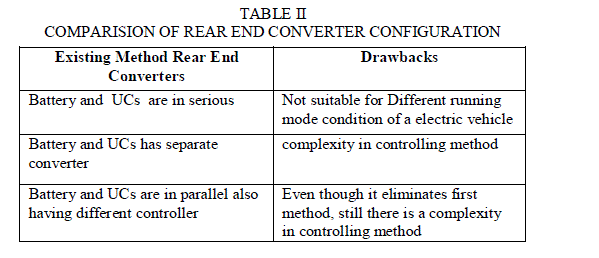 |
| B. Rear End Converter topology |
| In the most widely used conventional HESS designs, the battery pack is directly connected to the DC link while a half bridge converter is placed between the UC bank and the DC link. However, in order to utilize the power density advantage of the UC, the half bridge converter must match the power level of the UC. In most cases, the half bridge converter is a significant portion of the cost. Although this design solves the problem of the peak power demands, the battery still suffers from frequent charge and discharge operations. To solve all these problems mentioned above, a new HESS is proposed in this paper. In addition Proposed Rear End converter is designed to solve the following problem found in conventional converters. |
| ïÃâ÷ It acts as a controllable switch between battery and Ultra Capacitor. |
| ïÃâ÷ Prevents frequent charging/discharging cycle of battery. |
| ïÃâ÷ Fast switching operation as it designed with MOSFET. |
| ïÃâ÷ It improves electric vehicle running condition by suitably selecting energy storage elements. |
III. CONVERTER DESIGN AND CONTROLLING TECHNIQUE |
| This paper is designed by two converter topology namely FEC and REC |
| These two converters are designed and operated independently. |
| ïÃâ÷ Front End Converter works only at vehicle standby mode |
| ïÃâ÷ Rear end converter works only at vehicle running mode |
| A complete circuit diagram of Rear End Converter is given in fig. no.3 |
| A. Design of Front End Converter |
| Switching frequency of a proposed system is designed by the following Eqn. no 1 |
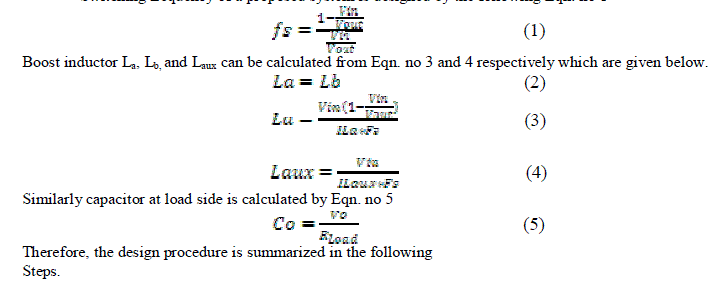 |
| ïÃâ÷ Select the minimum switching frequency, which correspond to the peak value of the input current. |
| ïÃâ÷ Calculate the value of the auxiliary inductance. |
| ïÃâ÷ Choose dead time so as to have enough time to completely charge and discharge the output capacitors of the MOSFETs |
| ïÃâ÷ Design the auxiliary inductor to have enough energy to be able to neutralize the valley current of the boost inductor and charge and discharge the output capacitor of the MOSFETs |
| ïÃâ÷ Design enough dead time to provide enough time for the output capacitors to charge and discharge. |
| B. Design of Rear End Converter |
| In designing a battery/UC HESS, the selection of the voltage strategy is strongly related to the characteristics of the battery and UCs used. Higher voltage capacity for the energy storage device presents a higher demand for the cell balancing circuit. This is because cell imbalances grow exponentially with the number of cells in series. One approach to reduce balancing needs is to use cells with lower performance variations (capacity, internal resistance, and self discharge rate). However, matched performance is essentially reached by cycling a big batch of cells and finding similar cells that can be grouped together. Therefore, depending on the characteristics of the battery and UC cells, a voltage tradeoff between the storage elements needs to be made. |
| Topology of a HESS depends significantly on the voltage strategy selected In the following discussion, V UC , V Batt , and DC V are referring to the voltage of the UC bank, voltage of the battery pack, and voltage of DC link, respectively. If (VUC < V Batt = VDC ), it indicates that a battery pack is connected directly to the DC link and a UC connected to the DC link through a bidirectional DC/DC converter. The advantage of this voltage strategy is the ability to use the entire range of the UC where a lower voltage UC bank is needed. |
| Rear End converter works as follows. |
| ïÃâ÷ During High acceleration mode condition, i.e when Electric motor requires high power, It connects Ultra capacitor to motor terminal unit as UCs has high power density capability |
| ïÃâ÷ Similarly, During less power density demand condition battery alone can meet load demand. Hence at that time REC disconnects UCs and connects Battery to motor terminal. This is illustrated in given flow chart in fig. no 4 |
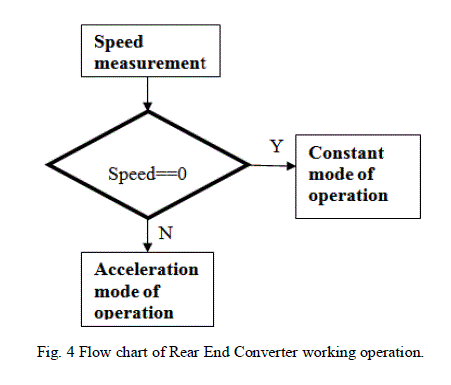 |
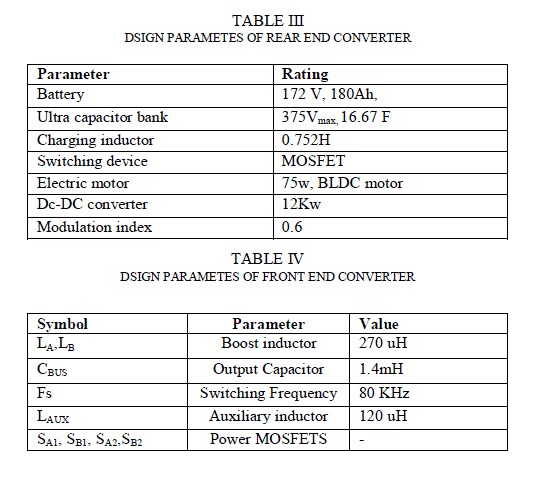 |
IV. SIMULATION AND RESULTS |
| This project is simulated in MATLAB R2010a tool which is an user friendly software. Two converters are designed by analysing by pulse pattern derived from above all design equations. Once pulse pattern is derived then it is easy to develop in MATLAB environment. Figure 5 and 6 shows pulse pattern of both the converter |
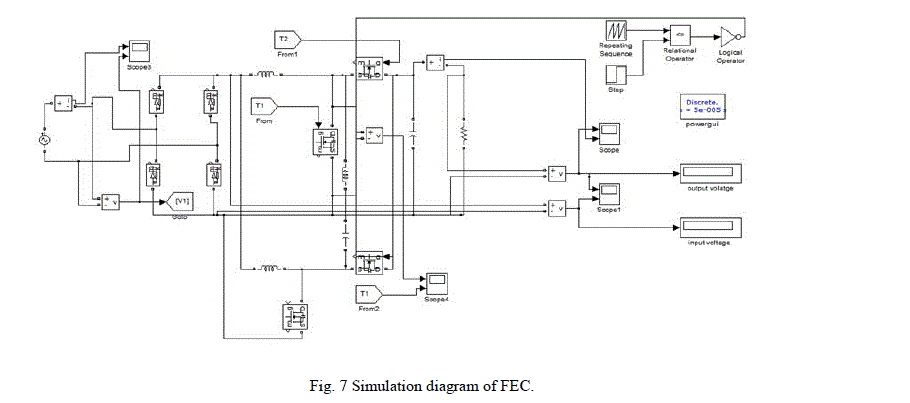 |
| Figure 7 shows the simulation diagram of both Front End Converter. This is simulated in MATLAB 2010 environment, where input current, input voltage, switching waveform across main switched are connected across scope. Hence all these values are viewed |
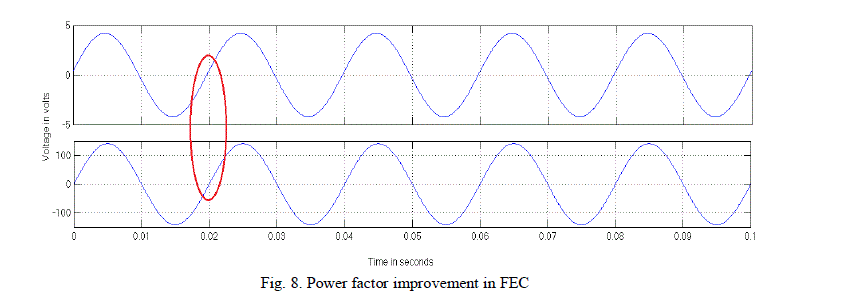 |
| Figure 8 shows power factor improvement in charging controller circuit. The upper graph is a input voltage and below one is as input current. Unity power factor is highlighted by red circle. |
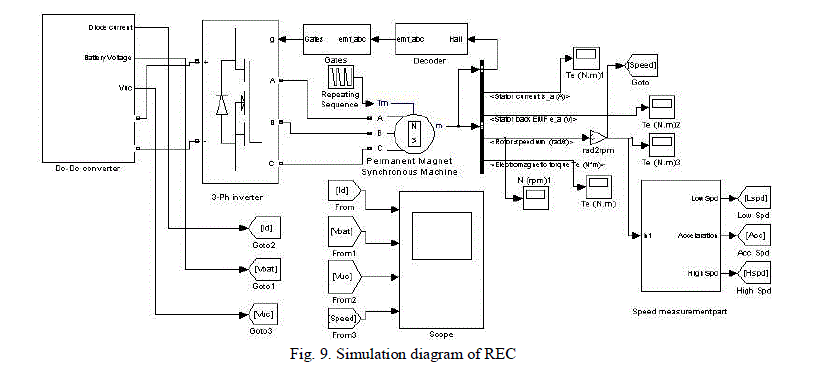 |
| Figure 9 shows a MATLAB simulation diagram of Rear End Converter and electric vehicle driving part. |
IV. CONCLUSION |
| Thus, a detailed analysis of a two different DC-DC converters used in Hybrid Electric Vehicle is presented in this paper. Their design procedure is also discussed. How these converters are operated in Electric vehicle is verified with help of MATLAB/simulink environment. |
References |
|